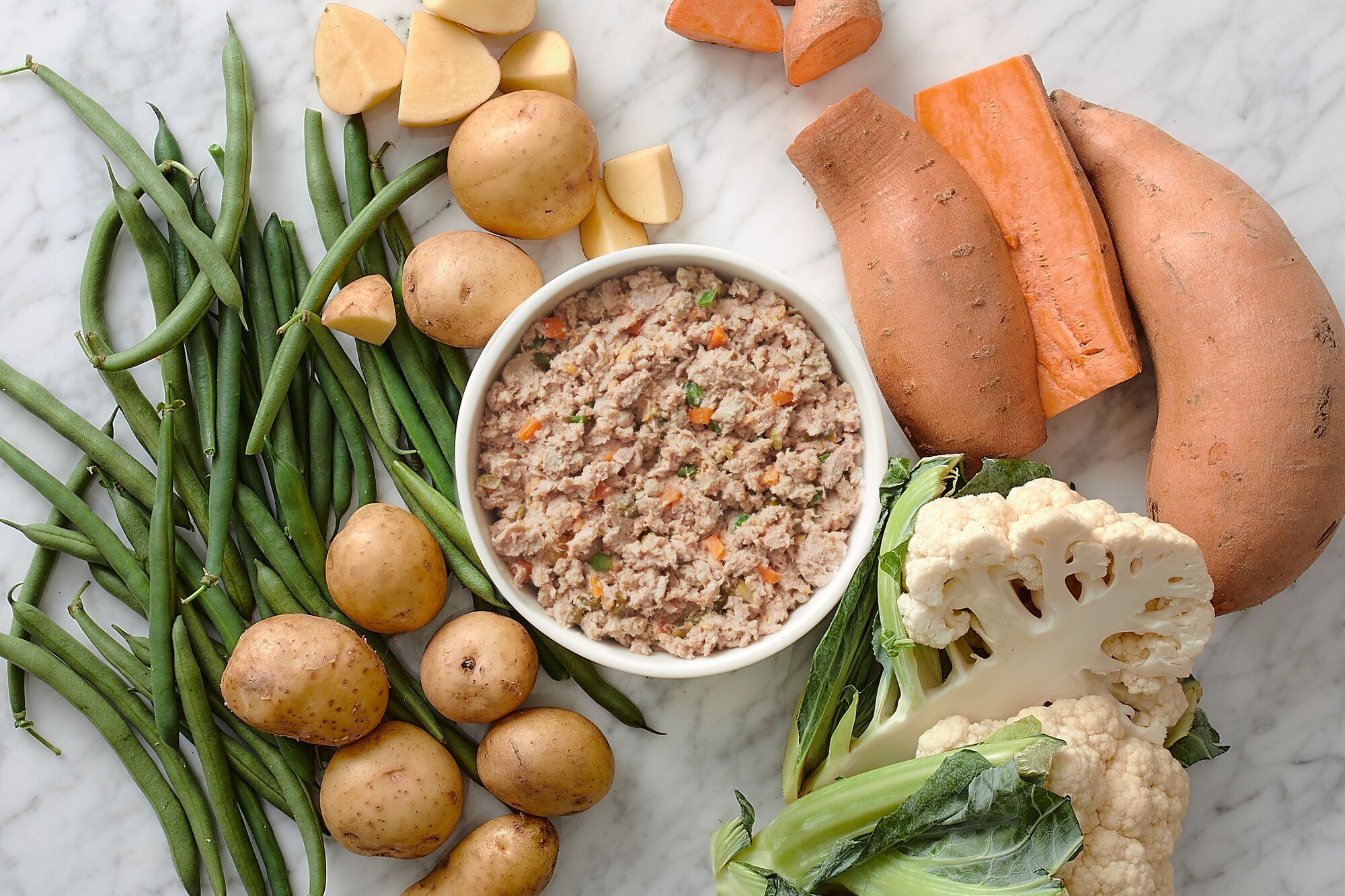Fiber can be a powerful force in a dog’s diet—but it’s not always easy to understand where they should get it and how much they should eat. Here’s our primer on roughage, and what it can do for your pup.
What is dietary fiber?
Fiber comes from plants, and is a type of carbohydrate that doesn’t get digested. It serves several important functions for a dog’s health.
Soluble vs. insoluble fiber
There are two types of fiber: soluble and insoluble. Dogs should eat both.
Soluble fiber can be dissolved in water. When it reaches your dog’s colon, it aids digestion by serving as food for the beneficial bacteria that live there. For this reason, soluble fibers are called “prebiotics”—they stimulate the growth of good bacteria.
Insoluble fiber, meanwhile, doesn’t dissolve. It bulks up stool as it moves through the colon, promoting regularity. It also gives dogs a sensation of fullness, making it easier for them to remain satisfied while staying at a healthy weight.
Fermentable vs. non-fermentable fiber
When fiber ferments in a dog’s gut, it produces short-chain fatty acids, which seem to have a number of beneficial effects for colon health; they may guard against issues like cancer, obesity, and diabetes.
Not all fiber can be fermented, and more soluble fiber also tends to be more fermentable. While fermentation has crucial benefits to health, you want to keep all things in balance. Too much fermentation can contribute to problems like flatulence.
Fiber and regularity
Fiber can regulate your dog’s bowels, preventing constipation and loose stools.
Dogs who don’t get enough fiber often have trouble eliminating, and adding the right amount can help them become regular.
It may sound counterintuitive that fiber can both speed up bowel movements and stop diarrhea—and it’s true that loose stools can be a result of too much fiber—but soluble fiber soaks up excess water, thus making watery bowel movements less likely. In any event, if your dog is having gastrointestinal issues, you should bring them to the veterinarian for an examination.
Better-regulated bowels are likely to mean a happier, healthier dog, and may help pups avoid problems like anal gland inflammation.
Fiber and diabetes
Veterinarians have found that high-fiber diets can help some diabetic dogs better manage their illnesses, but they’re not certain why that’s the case. In any event, if your dog shows signs of diabetes you should contact your vet for an examination and to come up with a plan to treat them; don’t try to figure it out by yourself or experiment at home.
How much fiber is in your dog’s food?
It can be difficult to be sure how much fiber is in a dog’s food. One issue is that most dog food labels list only crude fiber, as opposed to total dietary fiber. They also don’t break down the amounts of soluble and insoluble fiber—so a dog could get the same total amount of fiber, but a different mix of types, and not see the same results. Another challenge is that most dog food labels only list a maximum amount of crude fiber—not the quantity that’s actually in there.
If you’re not sure whether your dog is getting the right amount of fiber, don’t hesitate to talk to a vet.
Good sources of fiber for dogs
The idea of adding fiber to one’s diet by eating paper sounds like a joke, but kibble companies aren’t kidding when they use cellulose—which can come from paper or sawdust—to add fiber to their products. To be fair, you can find cellulose in a number of food products sold to humans as well; it might stop your shredded cheese from caking, for example. But because the fiber in cellulose is all insoluble, a dog who got fiber only from that source would miss key benefits.
Dogs who eat fresh food will get their fiber from vegetables like Brussels sprouts, broccoli, carrots, chickpeas, and green beans. The Farmer’s Dog uses these and other fiber-rich vegetables in its recipes.
Adding more fiber to a dog’s diet
While the most reliable way to make sure that your dog gets the right amount of fiber is to choose a complete and balanced food that meets their nutritional needs, dogs who require an extra boost can get it from various places. One popular option is canned pumpkin—not pumpkin-pie mix or anything else with added ingredients that could harm a dog. Various fruits and vegetables could also fit the bill, as can certain supplements. But before you do any of this, talk to a veterinarian about whether adding fiber is a good idea—and, if so, how much more your pal should get.
Dogs’ bodies change as they get older, and some senior dogs may benefit from more fiber if they’re experiencing constipation. Because fiber can make a dog feel fuller without consuming as many calories, it could also help stave off obesity in an older dog who’s less active. But vets sometimes recommend diets with less fiber for senior dogs if they are having trouble absorbing nutrients. As with many of these other questions, figuring out what works for your dog will involve paying close attention to them and discussing their specific needs with a vet.
Dogs can get too much fiber
Fiber is an important part of your dog’s diet, but more is not necessarily better. Be careful not to overdo it; dogs who eat too much fiber can experience weight loss, flatulence, bloating, diarrhea, and vomiting. That’s why humans should consult with a veterinarian when adding more fiber to their pup’s diet and do so a little bit at a time, monitoring the impact the changes have on their friend.










